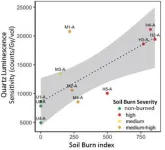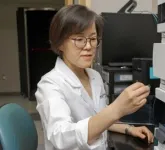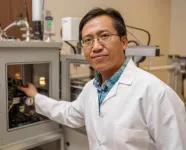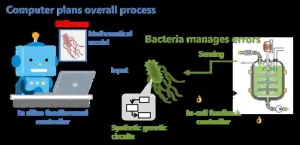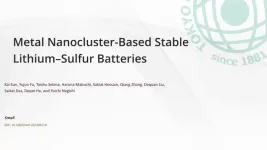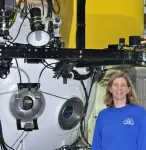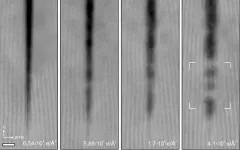(Press-News.org) Pittsburgh, Pa., USA: On 8 June 2020, the Mangum Fire ignited 16 miles north of the North Rim of Grand Canyon National Park. By the time it was mostly contained, about a month later, the fire had burned over 70,000 acres of land.
April Phinney, a M.Sc. candidate at Utah State University, immediately started drafting a burn intensity map based on remote sensing data. Six months later, she set boots on the burned ground and started collecting soil samples, hoping they would contain quartz grains. This research would become the basis of a presentation being given by Phinney’s advisor, Tammy Rittenour, on Sunday, 15 October at the Geological Society of America’s GSA Connects 2023 meeting.
Quartz may be the most common mineral on Earth, but it’s anything but boring. The focus of Phinney’s research was quartz’s ability to luminesce (i.e., emit light). When a mineral is exposed to ionizing radiation, some of its atoms will eject an electron. Most of the time these electrons fall quickly back to their parent atom. But in quartz, there are often structural defects in the crystal (e.g., a titanium or sodium atom replacing a silicon atom, or a missing oxygen), which create “positive traps.” The ejected electrons may thus be pulled to one of these defects, which will hold it (“trap it”) for millions of years—or until the crystal is exposed to light or heat. When this happens, the electron is set free from the structural defect and can drop to a lower energy state (such as an atom missing an electron), releasing a photon in the process and resetting the luminescence clock. Dating applications use this luminescence signal to determine the last time the mineral was exposed to light or heat. In this study the age of the fire was already known, and the researchers instead used a measurement of the luminescence sensitivity (light produced per dose of radiation) to identify quartz grains that been exposed to elevated heat, which enhances the luminescence properties.
Wildfires, of course, provide an enormous amount of heat to the soil they raze; it was therefore conceptually understood that the intensity of quartz luminescence should be higher in sediments that had been exposed to wildfires. However, this had never been field-tested before, and Phinney set out to do so for the first time. Using luminescence measurements from fire-affected soil, she would test the relationship between burn severity and luminescence intensity.
In the field, Phinney collected soil samples inside the fire perimeter in different burn intensity zones. To establish quartz’s baseline luminescence level, she also collected a few samples outside the fire perimeter, in areas that had not burned for at least 70 years, according to U.S. Forest Service records.
Her results show that soil samples collected in wildfire-affected areas luminesce more than soil samples collected outside the fire perimeter. The difference between burn severity areas is also clear, with high burn intensity samples luminescing up to twice as much as medium burn intensity samples. Phinney’s field testing demonstrates that wildfire burn intensity is recorded in the magnitude of quartz luminescence.
If quartz luminescence intensity is a fingerprint of fire exposure in surface soils, then it can be used to assess past fire intensity. Burn intensity maps only exist for very recent fires, but quartz luminescence intensity can help us look back in time up to two million years. These data can be used as a proxy for fire regimes, a measurement of how frequent and intense naturally occurring wildfires are in a particular ecosystem over a long period of time. Understanding these patterns is key to understanding and predicting current and future fire regimes, with important implications for hazard mapping and mitigation strategies throughout the southwestern United States.
Quartz as a Recorder of Fire Intensity: A New Proxy Record from Quartz Luminscence Intensity
Contact: April Phinney, april.ivy.phinney@gmail.com
14: T100. Advancements in the Science and Management of Wildfire Impacts on the Critical Zone
Monday, 16 October 2023, 11:20–11:35 a.m.
The Geological Society of America ( https://www.geosociety.org) unites a diverse community of geoscientists in a common purpose to study the mysteries of our planet (and beyond) and share scientific findings. Members and friends around the world, from academia, government, and industry, participate in GSA meetings, publications, and programs at all career levels, to foster professional excellence. GSA values and supports inclusion through cooperative research, public dialogue on earth issues, science education, and the application of geoscience in the service of humankind.
# # #
END
Inferring wildfire intensity from quartz luminescence
New research presented at GSA Connects 2023
2023-10-12
ELSE PRESS RELEASES FROM THIS DATE:
Cancer Prevention and Research Institute of Texas awards grants to four TTUHSC Researchers
2023-10-12
The Cancer Prevention and Research Institute of Texas (CPRIT) recently awarded grants to four researchers from the Texas Tech University Health Sciences Center (TTUHSC). Combined, the grants will provide nearly $2.3 million that TTUHSC will use to conduct a pair of two-year pilot studies, acquire a state-of-the-art piece of laboratory equipment known as a cell sorter, and administer a colorectal cancer screening and prevention program.
Three of the recipients are from the TTUHSC School of Medicine, including Hongjun (Henry) Liang, Ph.D., a professor in the Department of Cell Physiology and Molecular Biophysics; Min Kang, Pharm.D., a professor ...
Proof-of-concept method advances bioprocess engineering for a smoother transition to biofuels
2023-10-12
One of the primary goals of bioprocess engineering is to increase the yield of the desired material while maintaining high production rates and low raw material utilization. This optimization is usually accomplished by controlling the behavior of microorganisms used in the process and ensuring that their biological capabilities are fully utilized. This control may be computerized (in silico feedforward) or autonomous (in-cell feedback) which predicts the optimization based on inputs received. However, a process-model mismatch (PMM) occurs when there is a discrepancy between the predicted and actual production processes.
A recent paper published in Scientific Reports demonstrates a ...
Revolutionizing energy storage: Metal nanoclusters for stable lithium–sulfur batteries
2023-10-12
The demand for efficient energy storage systems is ever increasing, especially due to the recent emergence of intermittent renewable energy and the adoption of electric vehicles. In this regard, lithium–sulfur batteries (LSBs), which can store three to five times more energy than traditional lithium-ion batteries, have emerged as a promising solution.
LSBs use lithium as the anode and sulfur as the cathode, but this combination poses challenges. One significant issue is the “shuttle effect,” in which intermediate lithium polysulfide ...
Toward a global scientific consensus: identifying vulnerable marine ecosystems through imagery
2023-10-12
The scientific community is taking a significant step towards establishing a consensus on the designation of Vulnerable Marine Ecosystems (VMEs) from imagery data, as highlighted in the new article titled "Towards a scientific community consensus on designating Vulnerable Marine Ecosystems from imagery," authored by Dr. Amy R. Baco and colleagues, and published in PeerJ Life & Environment.
“Many scientists around the world were working independently on a similar question: Given the UN Food and Agriculture Organization (FAO) regulations for deep-sea Vulnerable Marine Ecosystems ...
Surprising discovery shows electron beam radiation can repair nanostructures
2023-10-12
MINNEAPOLIS / ST. PAUL (10/12/2023)—In a surprising new study, researchers at the University of Minnesota Twin Cities have found that the electron beam radiation that they previously thought degraded crystals can actually repair cracks in these nanostructures.
The groundbreaking discovery provides a new pathway to create more perfect crystal nanostructures, a process that is critical to improving the efficiency and cost-effectiveness of materials that are used in virtually all electronic devices we use every day.
“For ...
UTSA study could remove carbon emissions from atmosphere
2023-10-12
Zachary Tonzetich, an associate professor in the UTSA College of Sciences’ chemistry department, is part of a duo that has been awarded a one-year, $100,000 grant from The Welch Foundation for a project that could remove carbon emissions from the atmosphere.
Tonzetich and his research collaborator Anthony Cozzolino, an associate professor in Texas Tech University’s chemistry department, were the recipients of a WelchX pilot grant this past August. The WelchX program brings together leading chemistry researchers from across Texas to address challenging issues that are ...
New research shows why hunting for the cheapest plane ticket is a waste of your time
2023-10-12
Buy your ticket on a Tuesday. Search in your browser’s incognito mode. Use a VPN to pretend you live in Suriname.
“There are so many hacks out there for finding cheaper airline tickets,” says Olivia Natan, an assistant professor of marketing at the Haas School of Business. “But our data shows many of these beliefs are wrong.”
With four colleagues—Ali Hortaçsu and Timothy Schwieg from the University of Chicago, Kevin Williams from Yale, and Hayden Parsley from the University of Texas at Austin—Natan looked deeply into the structure and processes behind how ...
Commonly prescribed hypertension drug, amlodipine, not actually dangerous
2023-10-12
A new paper in the journal Function, published by Oxford Univetrsity Press, finds that a widely prescribed drug for treating hypertension, amlodipine, is not dangerous for patients, despite recent concerns from researchers and clinicians that taking amlodipine may have risks.
Approximately 700,000 Americans die from hypertension each year and researchers believe some 116 million Americans (and one in five adults worldwide) have the disease, which is responsible for 7.6 million deaths per year. If untreated, hypertension significantly increases ...
Cycling in school improves teenagers’ mental health, but wider social factors may impact benefits
2023-10-12
Physical activity has positive effects on mental health and yet, activity rates are declining. This is particularly worrying because the mental well-being of teenagers continues to deteriorate. In the US, one in six school children is diagnosed with some type of mental disorder.
Riding bikes is a promising approach to introduce school-aged children to physical activity. Now, researchers in the US have investigated how adolescents’ psychosocial well-being changed after participating in a school-based cycling program.
“Participation in a school cycling education program during the Covid-19 pandemic was associated with improved psychosocial well-being amongst middle schoolers in the ...
New technology for customized air purification of toxic gases
2023-10-12
Volatile organic compounds (VOCs) in daily products such as paints, adhesives, furniture, cosmetics, and deodorants make our lives easier. However, constant exposure can cause serious health problems such as respiratory illness, headaches, dermatitis, and cancer. Natural ventilation is the most effective way to reduce VOCs in indoor air, but recently, air purifiers have become a common method to maintain indoor air quality due to the frequent extreme outdoor condition (e.g. high concentration of fine dust, heat waves, and extreme cold). Generally, air purifiers remove ...
LAST 30 PRESS RELEASES:
Why nail-biting, procrastination and other self-sabotaging behaviors are rooted in survival instincts
Regional variations in mechanical properties of porcine leptomeninges
Artificial empathy in therapy and healthcare: advancements in interpersonal interaction technologies
Why some brains switch gears more efficiently than others
UVA’s Jundong Li wins ICDM’S 2025 Tao Li Award for data mining, machine learning
UVA’s low-power, high-performance computer power player Mircea Stan earns National Academy of Inventors fellowship
Not playing by the rules: USU researcher explores filamentous algae dynamics in rivers
Do our body clocks influence our risk of dementia?
Anthropologists offer new evidence of bipedalism in long-debated fossil discovery
Safer receipt paper from wood
Dosage-sensitive genes suggest no whole-genome duplications in ancestral angiosperm
First ancient human herpesvirus genomes document their deep history with humans
Why Some Bacteria Survive Antibiotics and How to Stop Them - New study reveals that bacteria can survive antibiotic treatment through two fundamentally different “shutdown modes”
UCLA study links scar healing to dangerous placenta condition
CHANGE-seq-BE finds off-target changes in the genome from base editors
The Journal of Nuclear Medicine Ahead-of-Print Tip Sheet: January 2, 2026
Delayed or absent first dose of measles, mumps, and rubella vaccination
Trends in US preterm birth rates by household income and race and ethnicity
Study identifies potential biomarker linked to progression and brain inflammation in multiple sclerosis
Many mothers in Norway do not show up for postnatal check-ups
Researchers want to find out why quick clay is so unstable
Superradiant spins show teamwork at the quantum scale
Cleveland Clinic Research links tumor bacteria to immunotherapy resistance in head and neck cancer
First Editorial of 2026: Resisting AI slop
Joint ground- and space-based observations reveal Saturn-mass rogue planet
Inheritable genetic variant offers protection against blood cancer risk and progression
Pigs settled Pacific islands alongside early human voyagers
A Coral reef’s daily pulse reshapes microbes in surrounding waters
EAST Tokamak experiments exceed plasma density limit, offering new approach to fusion ignition
Groundbreaking discovery reveals Africa’s oldest cremation pyre and complex ritual practices
[Press-News.org] Inferring wildfire intensity from quartz luminescenceNew research presented at GSA Connects 2023

